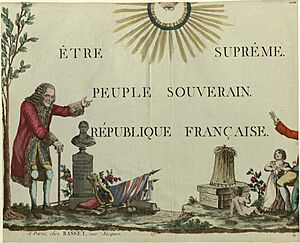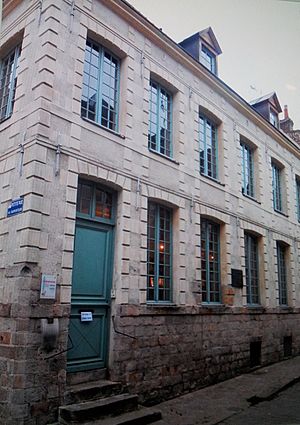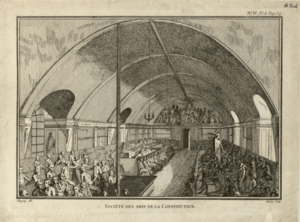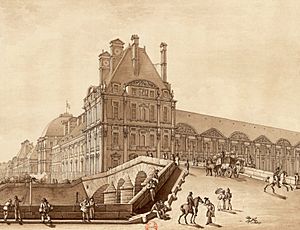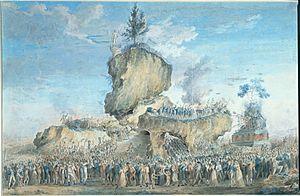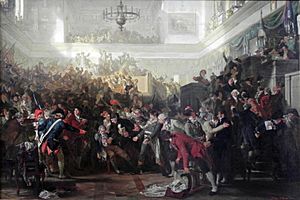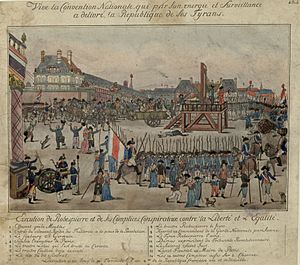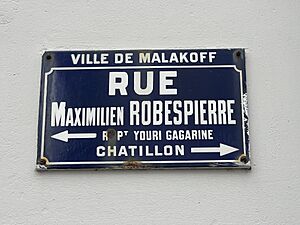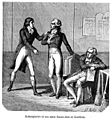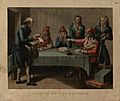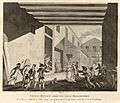Maximilien Robespierre facts for kids
Quick facts for kids
Maximilien Robespierre
|
|
|---|---|

A portrait of Robespierre from around 1790.
|
|
| Member of the Committee of Public Safety | |
| In office 27 July 1793 – 27 July 1794 |
|
| Preceded by | Thomas-Augustin de Gasparin |
| Succeeded by | Jacques Nicolas Billaud-Varenne |
| In office 25 March 1793 – 3 April 1793 Member of the Committee of General Defence |
|
| President of the National Convention | |
| In office 4 June 1794 – 19 June 1794 |
|
| Preceded by | Claude-Antoine Prieur-Duvernois |
| Succeeded by | Élie Lacoste |
| In office 22 August 1793 – 7 September 1793 |
|
| Preceded by | Marie-Jean Hérault de Séchelles |
| Succeeded by | Jacques-Nicolas Billaud-Varenne |
| President of the Jacobin Club | |
| In office 7 August 1793 – 28 August 1793 |
|
| In office 31 March 1790 – 3 June 1790 |
|
| Deputy of the National Convention | |
| In office 20 September 1792 – 27 July 1794 |
|
| Constituency | Paris |
| Deputy of the National Constituent Assembly | |
| In office 9 July 1789 – 30 September 1791 |
|
| Constituency | Artois |
| Deputy of the National Assembly | |
| In office 17 June 1789 – 9 July 1789 |
|
| Constituency | Artois |
| Deputy to the Estates General for the Third Estate |
|
| In office 6 May 1789 – 16 June 1789 |
|
| Constituency | Artois |
| Personal details | |
| Born |
Maximilien François Marie Isidore de Robespierre
6 May 1758 Arras, Artois, Kingdom of France |
| Died | 28 July 1794 (aged 36) Place de la Révolution, Paris, France |
| Cause of death | Execution by guillotine |
| Political party | The Mountain (1792–1794) |
| Other political affiliations |
Jacobin Club (1789–1794) |
| Alma mater | University of Paris |
| Profession |
|
| Signature | |
Maximilien Robespierre (May 6, 1758 – July 28, 1794) was a French lawyer and politician. He is one of the most famous and controversial leaders of the French Revolution.
Robespierre fought for the rights of all men to vote and to join the National Guard. He also supported the right to carry weapons for self-defense and wanted to end the slave trade. He was a powerful member of a political group called the Jacobin Club.
In 1793, he joined the Committee of Public Safety, which acted as France's government during the Revolution. This period became known as the Reign of Terror, where many people seen as enemies of the Revolution were executed. Because of this, many other leaders turned against him. On July 27, 1794, Robespierre was arrested and executed the next day.
Robespierre is a complicated figure in history. He is remembered for his progressive ideas but also for his role in the violence of the Revolution. People still debate his legacy today.
Contents
Early Life and Education
Maximilien de Robespierre was born in Arras, France, on May 6, 1758. His father was a lawyer, and Maximilien was the oldest of four children. His mother died when he was six years old. Soon after, his father left, and Maximilien and his brother were raised by their grandparents.
He was a very good student. At age 11, he earned a scholarship to a famous school in Paris, the Collège Louis-le-Grand. There, he studied law and became fascinated with the ancient Roman Republic. He admired famous Roman speakers like Cicero and Cato.
Robespierre was also inspired by the philosopher Jean-Jacques Rousseau. Rousseau wrote about democracy and the "general will" of the people. Robespierre believed that the government should follow the will of its citizens. These ideas shaped his thinking during the French Revolution.
Early Career and the Start of the Revolution
After graduating from law school in 1781, Robespierre became a lawyer in his hometown of Arras. He was known for defending the poor and speaking out against unfair laws. He became a judge but soon quit because he did not want to sentence people to death.
In 1789, King Louis XVI called a meeting of the Estates-General to solve France's financial problems. Robespierre was elected to represent the Third Estate (the common people). He quickly became known for his powerful speeches demanding more rights for ordinary citizens.
When the Third Estate declared itself the National Assembly, Robespierre joined them. He moved to Paris and became a leading member of the Jacobin Club, a group of radical revolutionaries. He argued for equality before the law for all people, including Protestants, Jews, and free people of color.
Rise to Power in the Revolution
Robespierre became a very influential speaker in the National Assembly. He argued against giving the king too much power and fought for the rights of the poor. He famously helped create the motto of the revolution: "Liberté, égalité, fraternité" (Liberty, Equality, Fraternity).
In 1791, after King Louis XVI tried to escape France, Robespierre argued that the king could not be trusted. He became a popular figure among the common people of Paris, who called him "The Incorruptible" because he seemed impossible to bribe.
When France went to war with Austria in 1792, Robespierre warned against it. He feared that the war would lead to a military dictatorship. His predictions made him a respected voice among the Jacobins.
The National Convention and the King's Execution
In September 1792, the monarchy was abolished, and France was declared a republic. Robespierre was elected to the new government, called the National Convention. In the Convention, he was a leader of the radical faction known as the Montagnards.
One of the first major debates was what to do with King Louis XVI. Robespierre argued that the king was a traitor and must be executed to save the revolution. On January 21, 1793, Louis XVI was executed by guillotine. This event marked a turning point in the Revolution, and Robespierre's influence grew even stronger.
The Reign of Terror
In the summer of 1793, France was in chaos. The country was at war with other European nations, and there were rebellions inside France. To deal with these threats, the Convention created the Committee of Public Safety. On July 27, 1793, Robespierre was elected to the Committee.
The Committee had immense power. It organized the army, controlled food supplies, and hunted down "enemies of the Revolution." This period became known as the Reign of Terror. A special court called the Revolutionary Tribunal was set up to try suspected traitors.
Robespierre believed that terror was necessary to protect the republic from its enemies. In a famous speech, he said that "terror is nothing other than justice, prompt, severe, inflexible." During the Reign of Terror, thousands of people were arrested and executed.
The Cult of the Supreme Being
Robespierre was not an atheist. He believed in God and thought that religion was important for a good society. However, he disliked the Catholic Church. He created a new state religion called the Cult of the Supreme Being.
This new religion was based on deist beliefs, which hold that God created the universe but does not interfere in it. On June 8, 1794, Robespierre led a huge festival in Paris to celebrate the Supreme Being. He hoped this would unite the French people around shared moral values. However, many people thought he was trying to become a dictator or even a god himself.
Downfall and Execution
By the summer of 1794, many people in France were tired of the Reign of Terror. The French army was winning its wars, and the country was no longer in immediate danger. People began to question why the executions needed to continue.
Robespierre's fellow revolutionaries started to fear him. He had many of his own allies, like Georges Danton, executed. Other leaders worried they would be next. They formed a secret plot to remove him from power.
On July 26, 1794, Robespierre gave a speech in the Convention, claiming there was a new conspiracy against the republic. When other deputies demanded he name the conspirators, he refused. This made everyone feel threatened.
The next day, on 9 Thermidor (the date in the French Revolutionary Calendar), his opponents took action. When Robespierre tried to speak, he was shouted down. The Convention voted to arrest him, his brother Augustin, and his close allies.
Final Hours and Execution
Robespierre and his followers were taken to the Paris city hall, the Hôtel de Ville, by their supporters in the Paris Commune. But the Convention sent troops to arrest them.
On July 28, 1794, Robespierre and 21 of his allies were taken to the Place de la Révolution. Without a trial, they were executed by guillotine. The crowd cheered as the man who had led the Reign of Terror was put to death. His death marked the end of the most radical phase of the French Revolution.
Legacy
Maximilien Robespierre is one of the most controversial figures in history. For some, he was a hero who fought for democracy and the rights of the poor. They see him as a defender of the Revolution who did what was necessary to save France from its enemies.
For others, he was a tyrant whose thirst for power led to the deaths of thousands. They blame him for the violence and extremism of the Reign of Terror. After his death, his enemies portrayed him as a monster to justify their own actions.
Historians continue to debate his true character and motives. Was he a selfless idealist or a ruthless dictator? Whatever the answer, his actions had a profound impact on the course of the French Revolution and the modern world.
Interesting facts about Maximilien Robespierre
- Robespierre's family has been traced back to the 15th century in Vaudricourt, Pas-de-Calais.
- His paternal grandfather, also named Maximilien de Robespierre, established himself as a lawyer. It has been suggested that he was of Irish descent, his surname possibly a corruption of "Robert Speirs".
- He earned the nickname "the incorruptible" for his adherence to strict moral values.
- Robespierre never gave up wearing a culotte and always had his hair powdered, curled and perfumed.
- He coined the famous motto "Liberté, égalité, fraternité" of the French Revolution by adding the word fraternity on the flags of the National Guard.
Images for kids
See also
 In Spanish: Maximilien Robespierre para niños
In Spanish: Maximilien Robespierre para niños


